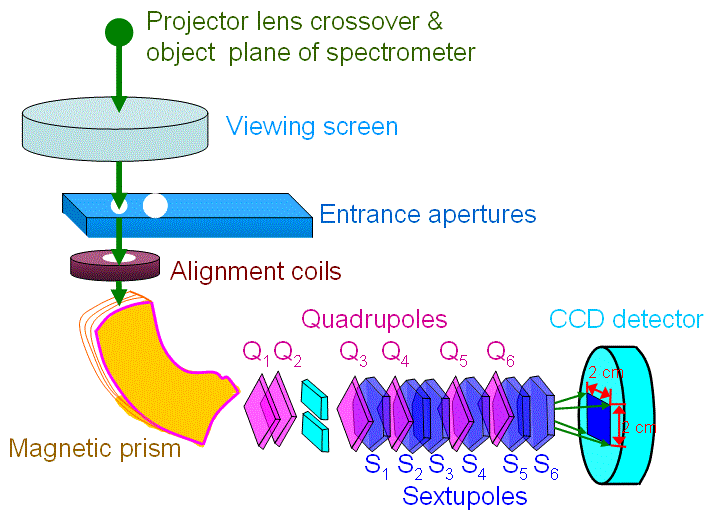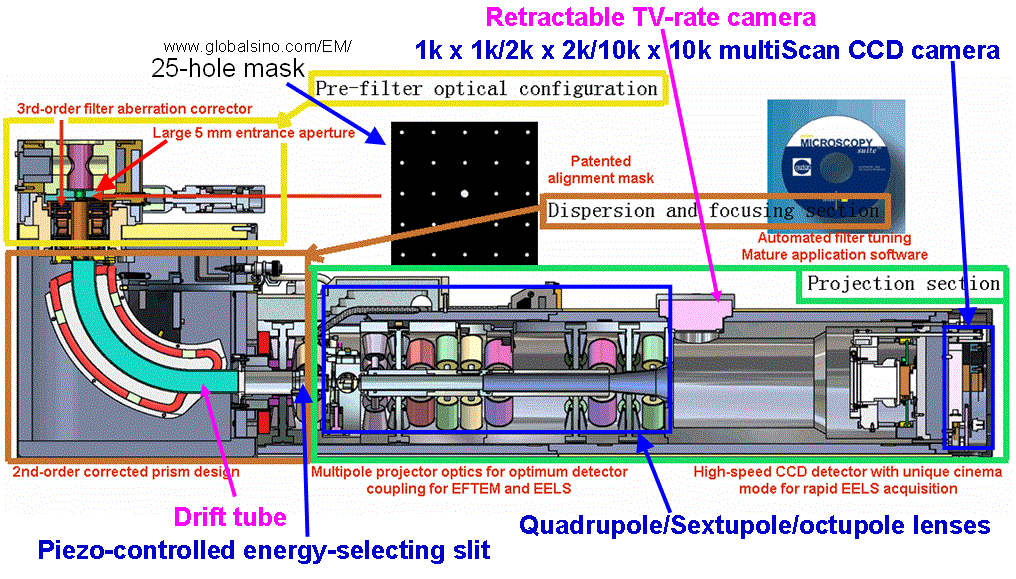=================================================================================
The spectrometers normally have two apertures which are entrance and beam trap apertures as shown in bottom image in Figure 4934a below. If it is in diffraction mode and the control collection angle (β) is controled by the entrance aperture, then a large aperture (high
intensity, high β) will lower the resolution and vice
versa. Therefore, there is a trade-off between the EELS signal strength and energy resolution in the selection of the entrance aperture (also called collector aperture) sizes, because of the following reasons:
i) The aberrations are worse, and thus the energy resolution is degraded as the width of the electron beam entering the prism increases.
ii) The collector aperture limits the number of electrons entering the prism more significantly, and thus the efficiency of the spectrum detection decreases as the width of the electron beam entering the prism decreases.
The spectrometer
entrance aperture, typically variable from 0.5 to 5 mm in
diameter, limits the range of entrance angles and ensures
adequate energy resolution. In 2009, the availability of the fifth-order aberration correction in GIF Quantum allowed a 9-mm entrance aperture.

Figure 4934a. Top image: example of Gatan spectrometers; Bottom image: schematic of spectrometer.
There are two apertures located in the spectrometer. The components labelled
Q1–Q4 are quadrupole electron lenses.
For the most common EFTEM unit as shown in Figure 4934b, the detection system consists of a slow scan CCD array detector rather than a single line of diodes used in PEELS detector. Note that an entrance aperture is selected in the figure.

Figure 4934b. Gatan imaging filter using CCD detector.
Figure 4934c shows the schematic illustration of a GIF (Gatan Imaging Filter) camera. The entrance aperture and piezo-controlled energy selecting slit (also called beam trap aperture in Figure 4934a) in the GIF system is also indicated in the figure. As an example, the GIF (Gatan imaging filter) Quantum employs fifth-order aberration correction, a 9-mm entrance aperture, faster CCD readout, and a 1-μs electrostatic shutter to allow simultaneous recording of the low-energy-loss and core-loss regions of a spectrum.

Figure 4934c. Schematic illustration of a GIF (Gatan Imaging Filter) camera. Adapted from [1]
The entrance aperture assembly in modern TEMs is controlled by a computer to position a selected entrance aperture to intercept the electron beam or to retract the aperture fully to permit the entire beam to enter the filtering system. Note that more than one aperture size or shape is normally included in a given EFTEM system.
Note that the GIF entrance aperture can be blocked by dirt so that no GIF images are observed.
[1] https://www.gatan.com.
|